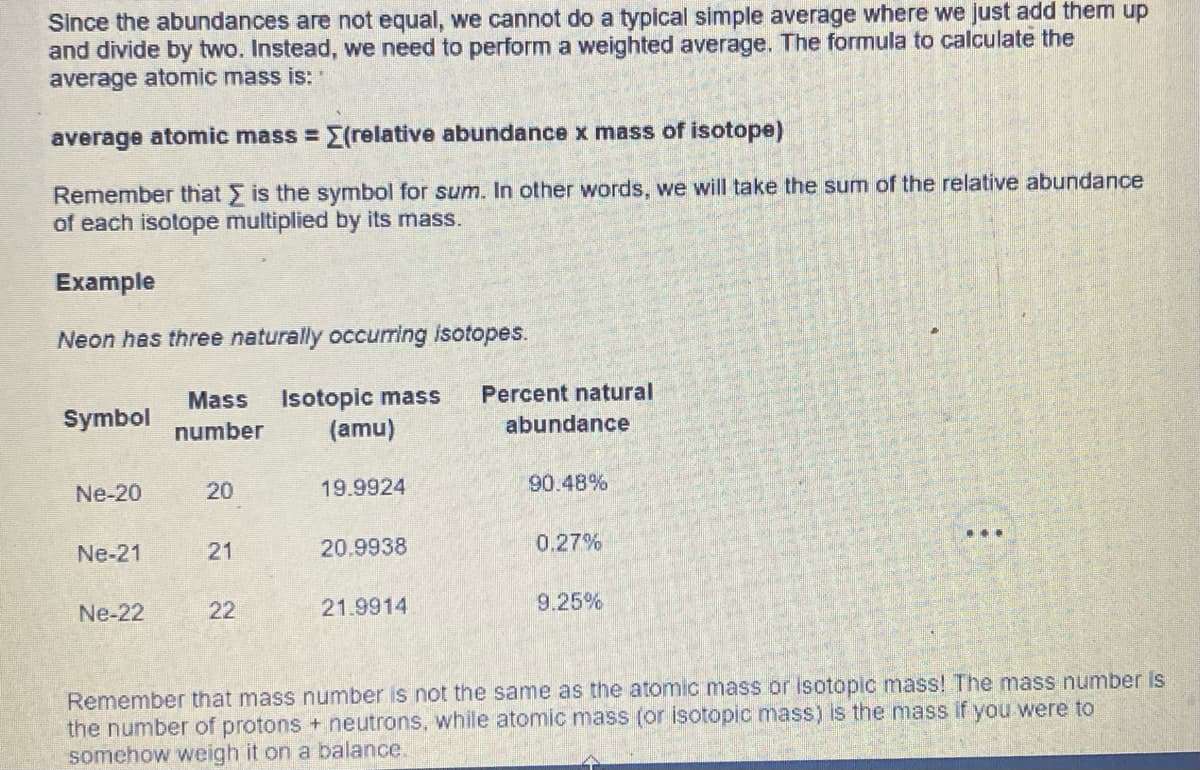Remember that is the symbol for sum. In other words, we will take the sum of the relative abundance of each isotope multiplied by its mass. Example Neon has three naturally occurring isotopes. Symbol Ne-20 Ne-21 Ne-22 Mass Isotopic mass (amu) number 20 21 22 19.9924 20.9938 21.9914 Percent natural abundance 90.48% 0.27% 9.25% ***
Remember that is the symbol for sum. In other words, we will take the sum of the relative abundance of each isotope multiplied by its mass. Example Neon has three naturally occurring isotopes. Symbol Ne-20 Ne-21 Ne-22 Mass Isotopic mass (amu) number 20 21 22 19.9924 20.9938 21.9914 Percent natural abundance 90.48% 0.27% 9.25% ***
Chemistry: The Molecular Science
5th Edition
ISBN:9781285199047
Author:John W. Moore, Conrad L. Stanitski
Publisher:John W. Moore, Conrad L. Stanitski
Chapter2: Chemical Compounds
Section: Chapter Questions
Problem 129QRT
Related questions
Concept explainers
Atomic Structure
The basic structure of an atom is defined as the component-level of atomic structure of an atom. Precisely speaking an atom consists of three major subatomic particles which are protons, neutrons, and electrons. Many theories have been stated for explaining the structure of an atom.
Shape of the D Orbital
Shapes of orbitals are an approximate representation of boundaries in space for finding electrons occupied in that respective orbital. D orbitals are known to have a clover leaf shape or dumbbell inside where electrons can be found.
Question
Explain the difference between an average and a weighted average

Transcribed Image Text:Since the abundances are not equal, we cannot do a typical simple average where we just add them up
and divide by two. Instead, we need to perform a weighted average. The formula to calculate the
average atomic mass is:
average atomic mass = [(relative abundance x mass of isotope)
Remember that is the symbol for sum. In other words, we will take the sum of the relative abundance
of each isotope multiplied by its mass.
Example
Neon has three naturally occurring isotopes.
Symbol
Ne-20
Ne-21
Ne-22
Mass Isotopic mass Percent natural
number
(amu)
abundance
20
21
22
19.9924
20.9938
21.9914
90.48%
0.27%
9.25%
…..
Remember that mass number is not the same as the atomic mass or isotopic mass! The mass number is
the number of protons + neutrons, while atomic mass (or isotopic mass) is the mass if you were to
somehow weigh it on a balance.

Transcribed Image Text:Since the abundances are not equal, we cannot do a typical simple average where we just add them up
and divide by two. Instead, we need to perform a weighted average. The formula to calculate the
average atomic mass is:
+
Expert Solution
This question has been solved!
Explore an expertly crafted, step-by-step solution for a thorough understanding of key concepts.
Step by step
Solved in 2 steps

Knowledge Booster
Learn more about
Need a deep-dive on the concept behind this application? Look no further. Learn more about this topic, chemistry and related others by exploring similar questions and additional content below.Recommended textbooks for you

Chemistry: The Molecular Science
Chemistry
ISBN:
9781285199047
Author:
John W. Moore, Conrad L. Stanitski
Publisher:
Cengage Learning

Chemistry & Chemical Reactivity
Chemistry
ISBN:
9781133949640
Author:
John C. Kotz, Paul M. Treichel, John Townsend, David Treichel
Publisher:
Cengage Learning

Chemistry & Chemical Reactivity
Chemistry
ISBN:
9781337399074
Author:
John C. Kotz, Paul M. Treichel, John Townsend, David Treichel
Publisher:
Cengage Learning

Chemistry: The Molecular Science
Chemistry
ISBN:
9781285199047
Author:
John W. Moore, Conrad L. Stanitski
Publisher:
Cengage Learning

Chemistry & Chemical Reactivity
Chemistry
ISBN:
9781133949640
Author:
John C. Kotz, Paul M. Treichel, John Townsend, David Treichel
Publisher:
Cengage Learning

Chemistry & Chemical Reactivity
Chemistry
ISBN:
9781337399074
Author:
John C. Kotz, Paul M. Treichel, John Townsend, David Treichel
Publisher:
Cengage Learning

Introductory Chemistry: A Foundation
Chemistry
ISBN:
9781337399425
Author:
Steven S. Zumdahl, Donald J. DeCoste
Publisher:
Cengage Learning

Chemistry: Principles and Reactions
Chemistry
ISBN:
9781305079373
Author:
William L. Masterton, Cecile N. Hurley
Publisher:
Cengage Learning

World of Chemistry, 3rd edition
Chemistry
ISBN:
9781133109655
Author:
Steven S. Zumdahl, Susan L. Zumdahl, Donald J. DeCoste
Publisher:
Brooks / Cole / Cengage Learning